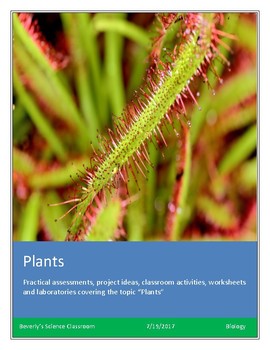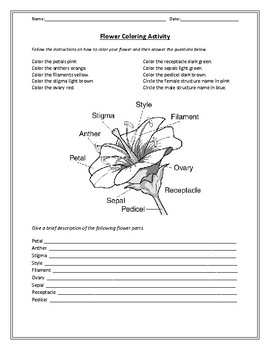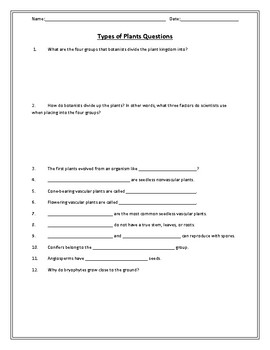Biology: The Plant Worksheets!
- PDF
Description
This is a worksheet series that includes over 23 different worksheets and handouts over photosynthesis, structures and systems, reproduction, classes and phyla, flowers, seeds, fruit, and leaves! Scroll down for additional details about this product and the worksheets included in this bundle.
Other Plant Material:
Complete Plant Overview PowerPoint
Different Types of Plants PowerPoint
Plant Structures and Systems PowerPoint
Plant Transport, Reproduction, and Response PowerPoint
Other Worksheet Bundles:
Introduction to Biology Worksheet Bundle
Taxonomy and Classification Worksheet Bundle
New! - Human Body Bundle
Worksheets Included in this bundle:
1. Types of Plants Questions
These are questions, fill in the blank and short answer that reviews the various types of plants. Students will need to be able to identify and describe the major groups of plants and how botanists divide plants into those groups.
2. Structures and Systems Questions
These are questions, fill in the blank and short answer that reviews the various structures of plants. Students will need to be able to identify and describe the major structures of plants, the purpose of those structures, and the difference between monocotyledons and dicotyledons.
3. Transport Questions
These are questions, fill in the blank and short answer that reviews the transport system in plants. Students will need to be able to identify and describe the transport system of both the xylem and phloem, the cells that make up those systems, as well as the process of transport throughout the plant.
4. Plant Reproduction Questions
These are questions, fill in the blank and short answer that reviews reproduction in plants. Students will need to be able to identify and describe the reproductive system in plants, the difference of that reproduction system between asexual and sexual plants, and the process of reproduction in plants.
5. Plant Response Questions
These are questions, fill in the blank and short answer that reviews the different responses in plants. Students will need to be able to describe the various types of responses in plants, describe how each response works and why.
6. Student Handout
This is a handout that identifies the structures of the leaf, a cross section of the leaf, structures of a flower, and the structures of a seed. This can be used as a handout so students may test over this information later, or as a handout to help the students through other assessments or worksheets. It also allows a notes section for students to take notes on any of the information provided.
7. Flower Coloring Activity
This is an activity that will work great with multiple age groups and skill levels. There is a picture of a flower. There are specific directions on what to color on the flower and which color it should be. At the bottom the students will also have to include a brief description of certain structures.
8. Seed Coloring Activity
This is an activity that will work great with multiple age groups and skill levels. There is a picture of a seed. There are specific directions on what to color on the seed and which color it should be. At the bottom the students will also have to include a brief description of certain structures.
9. Monocot or Dicot?
This is an activity where students will have to identify if a picture is representative of a monocotyledon or dicotyledon. There are 8 pictures that the students will identify. Some include a stem, some are the leaves, and some are various root structures.
10. Flower Labeling Worksheet/Assessment
This can be used one of several ways. Students can use this to look up the answers and complete as an activity and then use the completed worksheet as a study reference. This can also be used as a quiz since the pictures located in this worksheet/assessment are the same as the handout mentioned previously. This version does not have a word bank.
11. Flower Labeling Worksheet/Assessment with Word Bank
This can be used one of several ways. Students can use this to look up the answers and complete as an activity and then use the completed worksheet as a study reference. This can also be used as a quiz since the pictures located in this worksheet/assessment are the same as the handout mentioned previously. This version DOES have a word bank.
12. Leaf Labeling Worksheet/Assessment
This can be used one of several ways. Students can use this to look up the answers and complete as an activity and then use the completed worksheet as a study reference. This can also be used as a quiz since the pictures located in this worksheet/assessment are the same as the handout mentioned previously. This version does not have a word bank.
13. Leaf Labeling Worksheet/Assessment with Word Bank
This can be used one of several ways. Students can use this to look up the answers and complete as an activity and then use the completed worksheet as a study reference. This can also be used as a quiz since the pictures located in this worksheet/assessment are the same as the handout mentioned previously. This version DOES have a word bank.
14. Seed Labeling Worksheet/Assessment
This can be used one of several ways. Students can use this to look up the answers and complete as an activity and then use the completed worksheet as a study reference. This can also be used as a quiz since the pictures located in this worksheet/assessment are the same as the handout mentioned previously. This version does not have a word bank.
15. Seed Labeling Worksheet/Assessment with Word Bank
This can be used one of several ways. Students can use this to look up the answers and complete as an activity and then use the completed worksheet as a study reference. This can also be used as a quiz since the pictures located in this worksheet/assessment are the same as the handout mentioned previously. This version DOES have a word bank.
16. Plantae Graphic Organizer
This is a graphic organizer with the primary objective for students to identify characteristics of the kingdom Plantae. It is already constructed with the areas students have to fill in, so it can be a quick assignment for students to gain understanding without so much busy work.
17. Plantae Graphic Organizer with Phyla
This is a graphic organizer with the primary objective for students to identify characteristics of the kingdom Plantae. Students will also be able to see the relationships between the kingdom and the phylum under each as well as key characteristics. It is already constructed with the areas students have to fill in, so it can be a quick assignment for students to gain understanding without so much busy work.
18. Plant Cell Coloring
This is an activity that will work great with multiple age groups and skill levels. There is a picture of a plant cell. There are specific directions on what to color on the cell and which color it should be. At the bottom the students will also have to include a brief description of certain organelles/structures.
19. Comparing and Contrasting Gymnosperms and Angiosperms
This is an activity which includes a Venn Diagram for students to compare and contrast gymnosperms and angiosperms. At the end of the activity students will need to determine if they are more alike or different.
20. Comparing and Contrasting Types of Plants
This is also an activity which includes a Venn Diagram for students to compare and contrast three major types of plants. At the end of the activity, students will need to determine if these plants are more alike or different.
21. Design a Laboratory - Plants
This is an activity where students will be responsible for designing their own experiment. Students will need to develop a hypothesis that predicts how the color of light will affect photosynthesis. They will then design an experiment to test that hypothesis.
22. Plant Timeline
This activity is similar to the Cell Timeline. Students will create a timeline including the major discoveries of the plant and any advances in technology to be able to better study plants. They will need to include the date, name of the scientist(s), the discovery itself, and any other relevant details. They are provided space to complete.
23. Photosynthesis and Respiration
In this laboratory, students will observe photosynthesis and respiration of plants. Students will be given several small jars, such as baby food jars, and will set them up with plants and specific directions. Students will have to record the results. With questions, students will be responsible for interpreting the results, analyzing the changes, and identifying the processes of photosynthesis and respiration.





